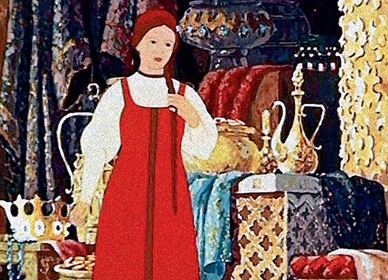- The Scarlet Flower (1952 film)
Infobox Film
name = The Scarlet Flower

caption =
imdb_rating =
director =Lev Atamanov
producer =Soyuzmultfilm
writer =Georgiy Grebner Sergei Aksakov (story) Y. Shvedov (lyrics)
starring =
narrator =
music =Nikolai Budashkin
cinematography =
editing =Lidiya Kyaksht
distributor =
released =1952 (USSR )
runtime = 42 min
country =USSR
language = Russian
budget =
preceded_by =
followed_by =
mpaa_rating =
tv_rating =
imdb_id ="The Scarlet Flower" ( _ru. А́ленький цвето́чек, "Alenkiy tsvetochek") is a 1952 Soviet traditionally-animated
feature film directedLev Atamanov . It was produced at theSoyuzmultfilm studio inMoscow and is based on the story of the same name bySergei Aksakov . The story is basically a variation of the taleBeauty and the Beast .The film is an example of the Socialist Realism period in Russian animation, which was characterized by heavy use of
rotoscoping and a focus on adapting traditional Russian folk tales. It was restored at theGorky Film Studio in 1987 and is now widely available on several video and DVD editions inRussia (an English-subtitled version has not been released).Plot
Before going on an overseas journey, a merchant father asks his three daughters what they would like him to bring back for them. The eldest asks for a shining tiara, the middle asks for a frame through which her face would always appear young, and the youngest (Nastenka) asks her father to bring her a beautiful scarlet flower like one which she saw in her dreams. Her elder sisters laugh at this simple wish.
The father's trip is successful and he finds everything that he came for, with the exception of Nastenka's scarlet flower. Nevertheless, the ship heaves off and they begin to head back while the father scans the lands around him for a scarlet flower.
A storm strikes and the father is washed overboard. He wakes up on a strange island which is full of all sorts of wonders. He explores, and eventually finds a flower just like the one Nastenka described. The instant that he plucks it, however, a great storm comes upon him and the owner of the island - a hideous monster - makes his presence known. He tells the father that he will let him keep the flower, but in return he must send one of his daughters to live with him. The father refuses, and the monster gives him a ring, telling him that whoever puts it on will be teleported back to the island, and that if his daughter doesn't come then he himself must come and be killed.
In the morning, the crewmembers of the father's ship (who had been searching for him) see him on the island and rescue him. Back home, the father prepares to put on the ring and meet his fate. However, Nastenka overhears a conversation where he reveals this to his friend and secretly puts on the ring herself.
There, she expects to be killed but instead finds herself on a beautiful island and welcomed for by a kind, unseen host. She accidentally catches a glimpse of him eventually, and is mortally scared at first. He allows her to go home to visit her family, but tells her that she must come back by putting on the ring by 8pm or he will die of loneliness.
Nastenka comes home dressed in splendid clothes and with presents for her sisters. Her sisters, however, become jealous and secretly turn all of the clocks in the house back two hours. Nastenka looks outside and hears the clock chiming 9pm, and quickly goes back, only to find the monster near death. She is very saddened and vows to never leave him again, and with those words the scarlet flower which she holds reattaches itself to its original stem and the island fills with light again. The monster turns into a handsome prince and explains that he was under the spell of a witch from which he could only be freed from if he won over the heart of a lady while being in the body of a hideous monster.
Creators
ee also
*
History of Russian animation
*List of animated feature films External links
* [http://kinejo.blogsome.com/2007/06/18/la-skarlata-floreto/ "The Scarlett Flower" watchable online and downloadable with Esperanto subtitles]
* [http://www.animator.ru/db/?ver=eng&p=show_film&fid=3016 "Alenkiy tsvetochek"] at theAnimator.ru (English and Russian)
* [http://www.myltik.ru/index.php?topic=db&fe=multview&multid=915 "Alenkiy tsvetochek" at myltik.ru] ru icon
* [http://www.close-up.ru/catalog/detail.php?FID=7405 "Alenkiy tsvetochek" at Krupnyy Plan] ru icon (restoration on DVD)
Wikimedia Foundation. 2010.
